ECON19031: Australian Wine Production and River Murray Pollution
VerifiedAdded on 2022/12/29
|17
|4218
|31
Report
AI Summary
This report examines the environmental consequences of Australian wine production, specifically focusing on its impact on the River Murray. The study delves into the issue of water pollution, highlighting how grape production and wine-making processes contribute to the degradation of water quality. It emphasizes the role of industrial effluents, toxic substances, and unsustainable practices as key drivers of pollution. The report explores the economic aspects of this environmental problem, applying concepts like demand and supply curves and the 'water footprint' to assess resource use and identify sustainable strategies. It analyzes the economic mechanisms at play, identifying the sources of the problem and who bears the costs, including the impact of fertilizer usage, outdated farming techniques, and external factors like floods and pests. The research also evaluates the application of 'water footprint' assessment to business operations, emphasizing the importance of recycling and improved water management to mitigate environmental risks. The report ultimately seeks to evaluate the environmental and economic impacts of wine production and suggests economic and policy mechanisms to enhance water management and minimize the negative impacts of pollution.
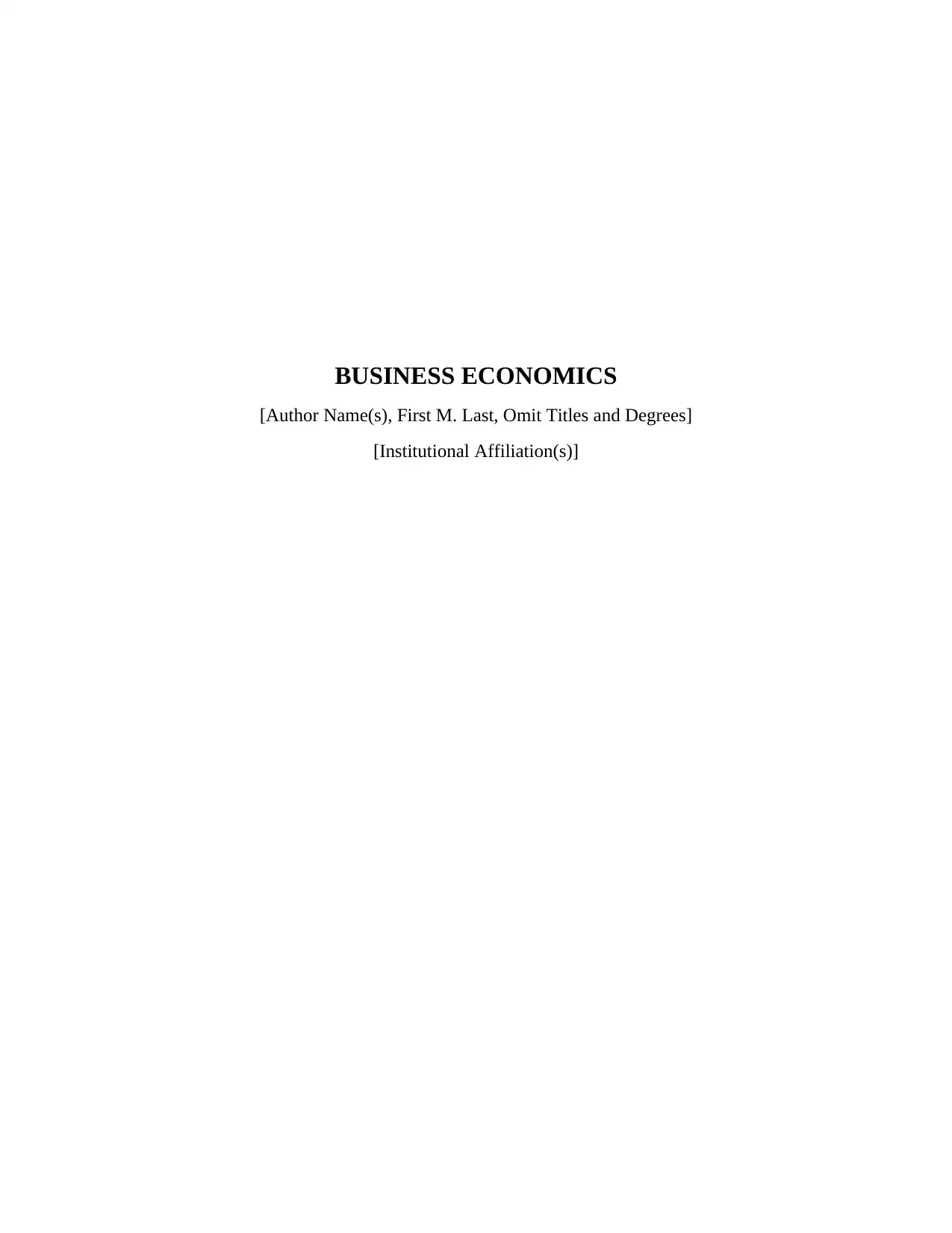
BUSINESS ECONOMICS
[Author Name(s), First M. Last, Omit Titles and Degrees]
[Institutional Affiliation(s)]
[Author Name(s), First M. Last, Omit Titles and Degrees]
[Institutional Affiliation(s)]
Paraphrase This Document
Need a fresh take? Get an instant paraphrase of this document with our AI Paraphraser
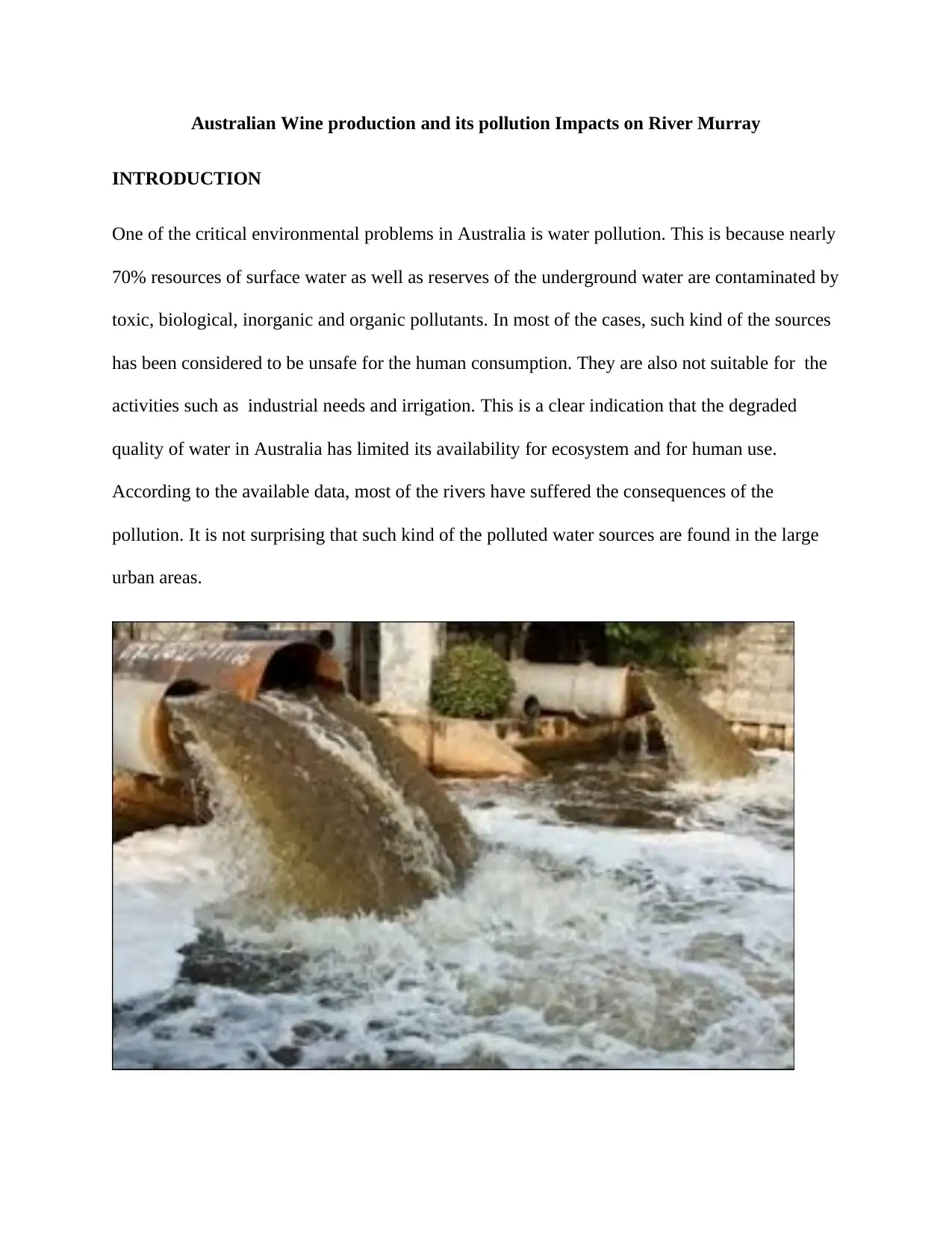
Australian Wine production and its pollution Impacts on River Murray
INTRODUCTION
One of the critical environmental problems in Australia is water pollution. This is because nearly
70% resources of surface water as well as reserves of the underground water are contaminated by
toxic, biological, inorganic and organic pollutants. In most of the cases, such kind of the sources
has been considered to be unsafe for the human consumption. They are also not suitable for the
activities such as industrial needs and irrigation. This is a clear indication that the degraded
quality of water in Australia has limited its availability for ecosystem and for human use.
According to the available data, most of the rivers have suffered the consequences of the
pollution. It is not surprising that such kind of the polluted water sources are found in the large
urban areas.
INTRODUCTION
One of the critical environmental problems in Australia is water pollution. This is because nearly
70% resources of surface water as well as reserves of the underground water are contaminated by
toxic, biological, inorganic and organic pollutants. In most of the cases, such kind of the sources
has been considered to be unsafe for the human consumption. They are also not suitable for the
activities such as industrial needs and irrigation. This is a clear indication that the degraded
quality of water in Australia has limited its availability for ecosystem and for human use.
According to the available data, most of the rivers have suffered the consequences of the
pollution. It is not surprising that such kind of the polluted water sources are found in the large
urban areas.
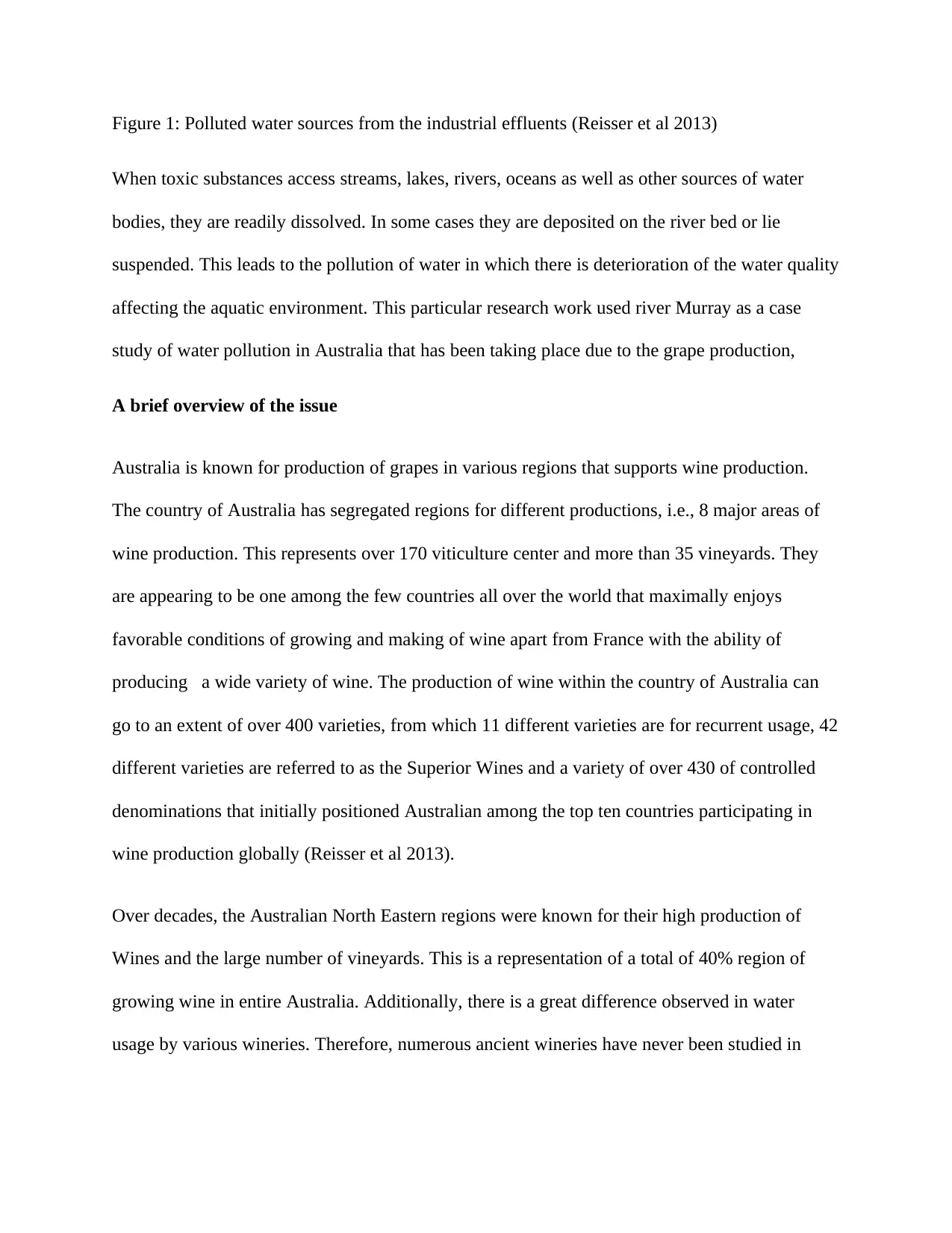
Figure 1: Polluted water sources from the industrial effluents (Reisser et al 2013)
When toxic substances access streams, lakes, rivers, oceans as well as other sources of water
bodies, they are readily dissolved. In some cases they are deposited on the river bed or lie
suspended. This leads to the pollution of water in which there is deterioration of the water quality
affecting the aquatic environment. This particular research work used river Murray as a case
study of water pollution in Australia that has been taking place due to the grape production,
A brief overview of the issue
Australia is known for production of grapes in various regions that supports wine production.
The country of Australia has segregated regions for different productions, i.e., 8 major areas of
wine production. This represents over 170 viticulture center and more than 35 vineyards. They
are appearing to be one among the few countries all over the world that maximally enjoys
favorable conditions of growing and making of wine apart from France with the ability of
producing a wide variety of wine. The production of wine within the country of Australia can
go to an extent of over 400 varieties, from which 11 different varieties are for recurrent usage, 42
different varieties are referred to as the Superior Wines and a variety of over 430 of controlled
denominations that initially positioned Australian among the top ten countries participating in
wine production globally (Reisser et al 2013).
Over decades, the Australian North Eastern regions were known for their high production of
Wines and the large number of vineyards. This is a representation of a total of 40% region of
growing wine in entire Australia. Additionally, there is a great difference observed in water
usage by various wineries. Therefore, numerous ancient wineries have never been studied in
When toxic substances access streams, lakes, rivers, oceans as well as other sources of water
bodies, they are readily dissolved. In some cases they are deposited on the river bed or lie
suspended. This leads to the pollution of water in which there is deterioration of the water quality
affecting the aquatic environment. This particular research work used river Murray as a case
study of water pollution in Australia that has been taking place due to the grape production,
A brief overview of the issue
Australia is known for production of grapes in various regions that supports wine production.
The country of Australia has segregated regions for different productions, i.e., 8 major areas of
wine production. This represents over 170 viticulture center and more than 35 vineyards. They
are appearing to be one among the few countries all over the world that maximally enjoys
favorable conditions of growing and making of wine apart from France with the ability of
producing a wide variety of wine. The production of wine within the country of Australia can
go to an extent of over 400 varieties, from which 11 different varieties are for recurrent usage, 42
different varieties are referred to as the Superior Wines and a variety of over 430 of controlled
denominations that initially positioned Australian among the top ten countries participating in
wine production globally (Reisser et al 2013).
Over decades, the Australian North Eastern regions were known for their high production of
Wines and the large number of vineyards. This is a representation of a total of 40% region of
growing wine in entire Australia. Additionally, there is a great difference observed in water
usage by various wineries. Therefore, numerous ancient wineries have never been studied in
⊘ This is a preview!⊘
Do you want full access?
Subscribe today to unlock all pages.

Trusted by 1+ million students worldwide
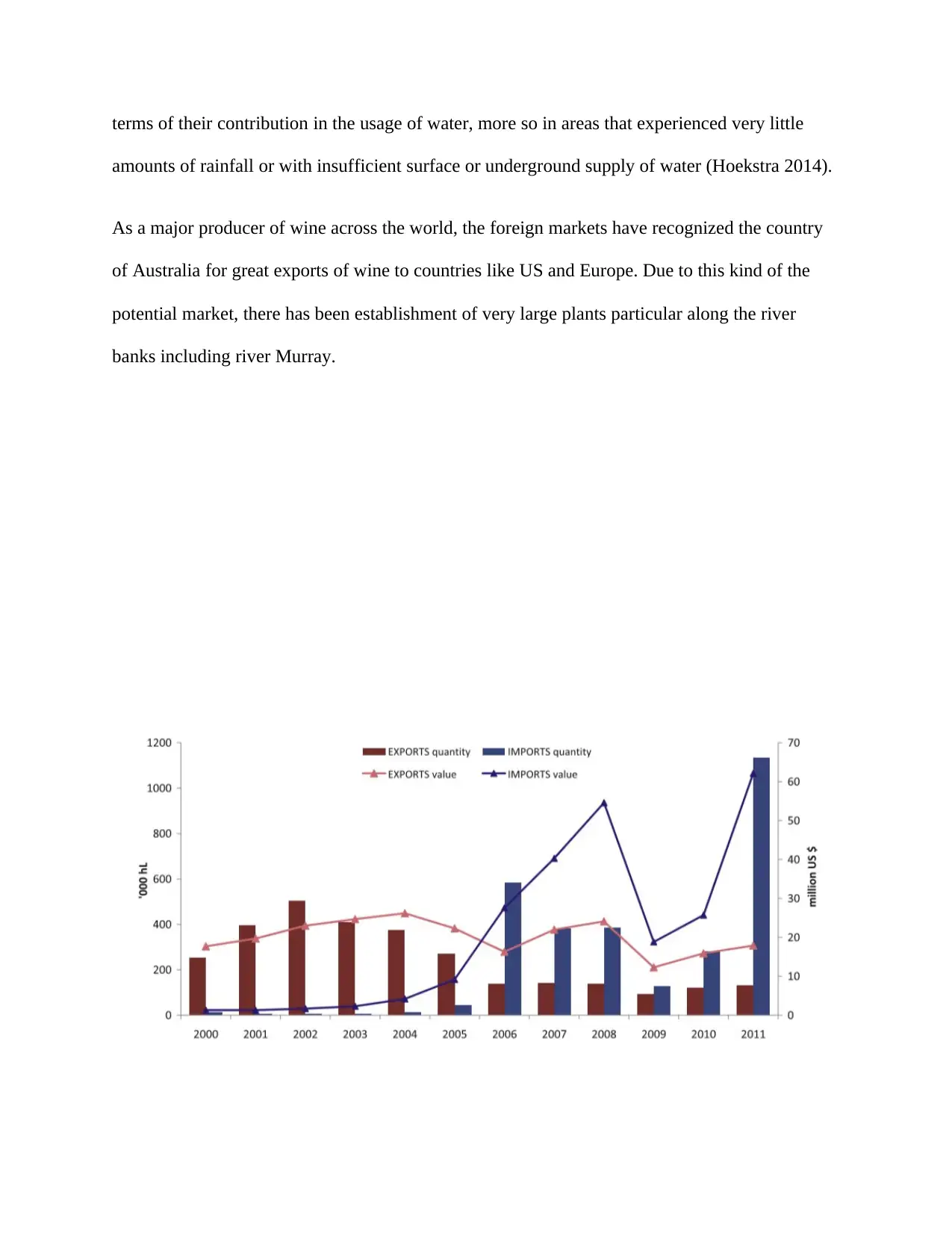
terms of their contribution in the usage of water, more so in areas that experienced very little
amounts of rainfall or with insufficient surface or underground supply of water (Hoekstra 2014).
As a major producer of wine across the world, the foreign markets have recognized the country
of Australia for great exports of wine to countries like US and Europe. Due to this kind of the
potential market, there has been establishment of very large plants particular along the river
banks including river Murray.
amounts of rainfall or with insufficient surface or underground supply of water (Hoekstra 2014).
As a major producer of wine across the world, the foreign markets have recognized the country
of Australia for great exports of wine to countries like US and Europe. Due to this kind of the
potential market, there has been establishment of very large plants particular along the river
banks including river Murray.
Paraphrase This Document
Need a fresh take? Get an instant paraphrase of this document with our AI Paraphraser
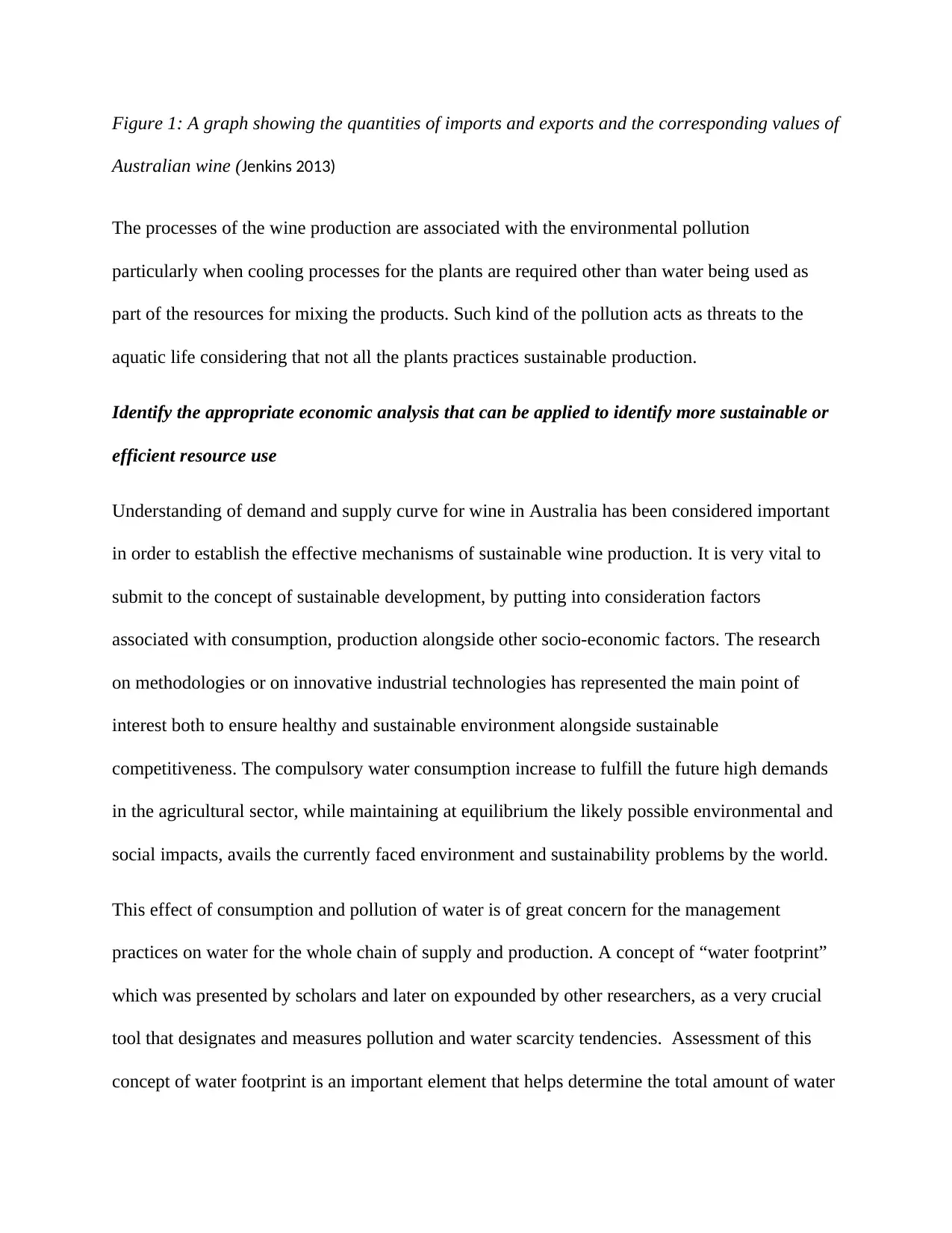
Figure 1: A graph showing the quantities of imports and exports and the corresponding values of
Australian wine (Jenkins 2013)
The processes of the wine production are associated with the environmental pollution
particularly when cooling processes for the plants are required other than water being used as
part of the resources for mixing the products. Such kind of the pollution acts as threats to the
aquatic life considering that not all the plants practices sustainable production.
Identify the appropriate economic analysis that can be applied to identify more sustainable or
efficient resource use
Understanding of demand and supply curve for wine in Australia has been considered important
in order to establish the effective mechanisms of sustainable wine production. It is very vital to
submit to the concept of sustainable development, by putting into consideration factors
associated with consumption, production alongside other socio-economic factors. The research
on methodologies or on innovative industrial technologies has represented the main point of
interest both to ensure healthy and sustainable environment alongside sustainable
competitiveness. The compulsory water consumption increase to fulfill the future high demands
in the agricultural sector, while maintaining at equilibrium the likely possible environmental and
social impacts, avails the currently faced environment and sustainability problems by the world.
This effect of consumption and pollution of water is of great concern for the management
practices on water for the whole chain of supply and production. A concept of “water footprint”
which was presented by scholars and later on expounded by other researchers, as a very crucial
tool that designates and measures pollution and water scarcity tendencies. Assessment of this
concept of water footprint is an important element that helps determine the total amount of water
Australian wine (Jenkins 2013)
The processes of the wine production are associated with the environmental pollution
particularly when cooling processes for the plants are required other than water being used as
part of the resources for mixing the products. Such kind of the pollution acts as threats to the
aquatic life considering that not all the plants practices sustainable production.
Identify the appropriate economic analysis that can be applied to identify more sustainable or
efficient resource use
Understanding of demand and supply curve for wine in Australia has been considered important
in order to establish the effective mechanisms of sustainable wine production. It is very vital to
submit to the concept of sustainable development, by putting into consideration factors
associated with consumption, production alongside other socio-economic factors. The research
on methodologies or on innovative industrial technologies has represented the main point of
interest both to ensure healthy and sustainable environment alongside sustainable
competitiveness. The compulsory water consumption increase to fulfill the future high demands
in the agricultural sector, while maintaining at equilibrium the likely possible environmental and
social impacts, avails the currently faced environment and sustainability problems by the world.
This effect of consumption and pollution of water is of great concern for the management
practices on water for the whole chain of supply and production. A concept of “water footprint”
which was presented by scholars and later on expounded by other researchers, as a very crucial
tool that designates and measures pollution and water scarcity tendencies. Assessment of this
concept of water footprint is an important element that helps determine the total amount of water
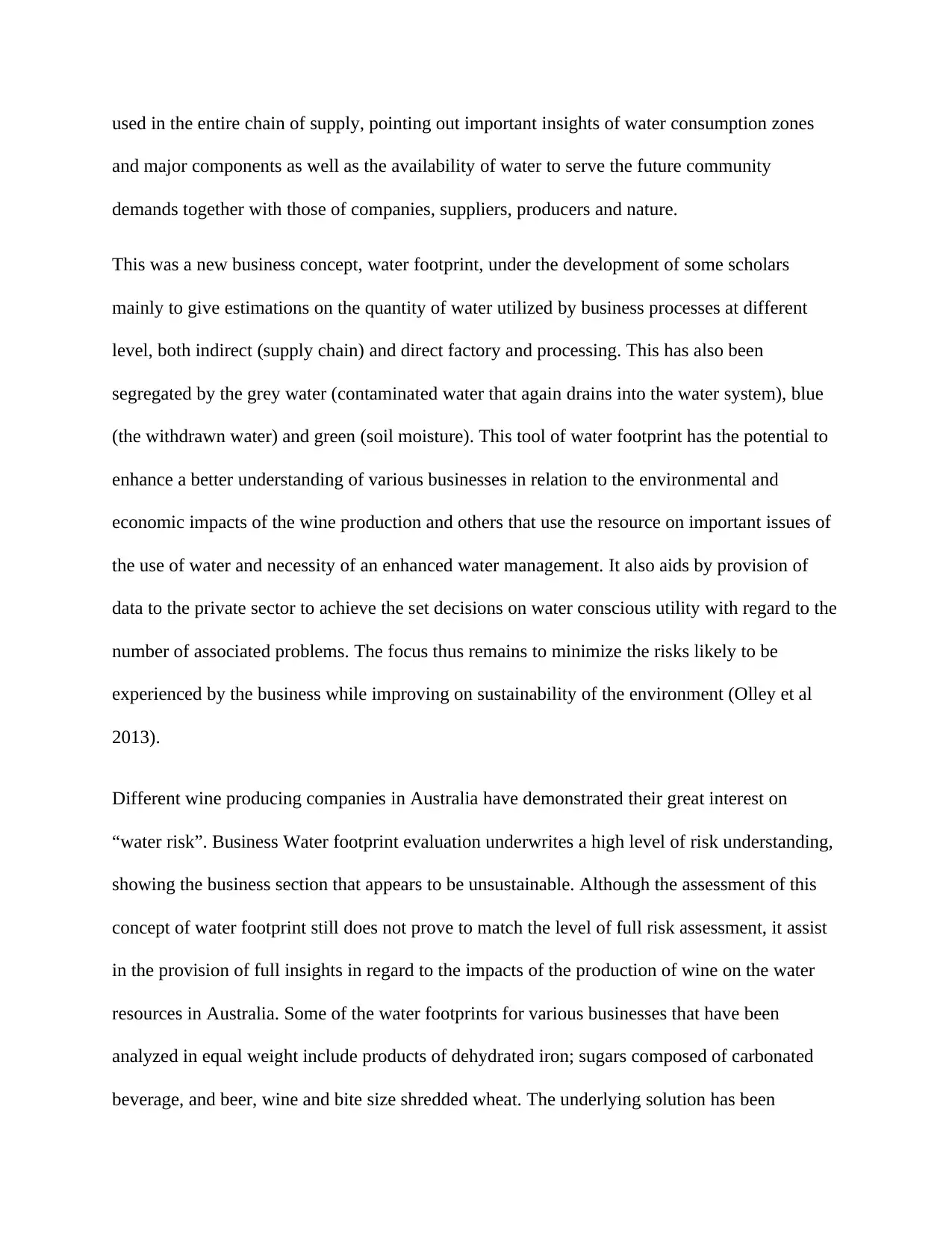
used in the entire chain of supply, pointing out important insights of water consumption zones
and major components as well as the availability of water to serve the future community
demands together with those of companies, suppliers, producers and nature.
This was a new business concept, water footprint, under the development of some scholars
mainly to give estimations on the quantity of water utilized by business processes at different
level, both indirect (supply chain) and direct factory and processing. This has also been
segregated by the grey water (contaminated water that again drains into the water system), blue
(the withdrawn water) and green (soil moisture). This tool of water footprint has the potential to
enhance a better understanding of various businesses in relation to the environmental and
economic impacts of the wine production and others that use the resource on important issues of
the use of water and necessity of an enhanced water management. It also aids by provision of
data to the private sector to achieve the set decisions on water conscious utility with regard to the
number of associated problems. The focus thus remains to minimize the risks likely to be
experienced by the business while improving on sustainability of the environment (Olley et al
2013).
Different wine producing companies in Australia have demonstrated their great interest on
“water risk”. Business Water footprint evaluation underwrites a high level of risk understanding,
showing the business section that appears to be unsustainable. Although the assessment of this
concept of water footprint still does not prove to match the level of full risk assessment, it assist
in the provision of full insights in regard to the impacts of the production of wine on the water
resources in Australia. Some of the water footprints for various businesses that have been
analyzed in equal weight include products of dehydrated iron; sugars composed of carbonated
beverage, and beer, wine and bite size shredded wheat. The underlying solution has been
and major components as well as the availability of water to serve the future community
demands together with those of companies, suppliers, producers and nature.
This was a new business concept, water footprint, under the development of some scholars
mainly to give estimations on the quantity of water utilized by business processes at different
level, both indirect (supply chain) and direct factory and processing. This has also been
segregated by the grey water (contaminated water that again drains into the water system), blue
(the withdrawn water) and green (soil moisture). This tool of water footprint has the potential to
enhance a better understanding of various businesses in relation to the environmental and
economic impacts of the wine production and others that use the resource on important issues of
the use of water and necessity of an enhanced water management. It also aids by provision of
data to the private sector to achieve the set decisions on water conscious utility with regard to the
number of associated problems. The focus thus remains to minimize the risks likely to be
experienced by the business while improving on sustainability of the environment (Olley et al
2013).
Different wine producing companies in Australia have demonstrated their great interest on
“water risk”. Business Water footprint evaluation underwrites a high level of risk understanding,
showing the business section that appears to be unsustainable. Although the assessment of this
concept of water footprint still does not prove to match the level of full risk assessment, it assist
in the provision of full insights in regard to the impacts of the production of wine on the water
resources in Australia. Some of the water footprints for various businesses that have been
analyzed in equal weight include products of dehydrated iron; sugars composed of carbonated
beverage, and beer, wine and bite size shredded wheat. The underlying solution has been
⊘ This is a preview!⊘
Do you want full access?
Subscribe today to unlock all pages.

Trusted by 1+ million students worldwide
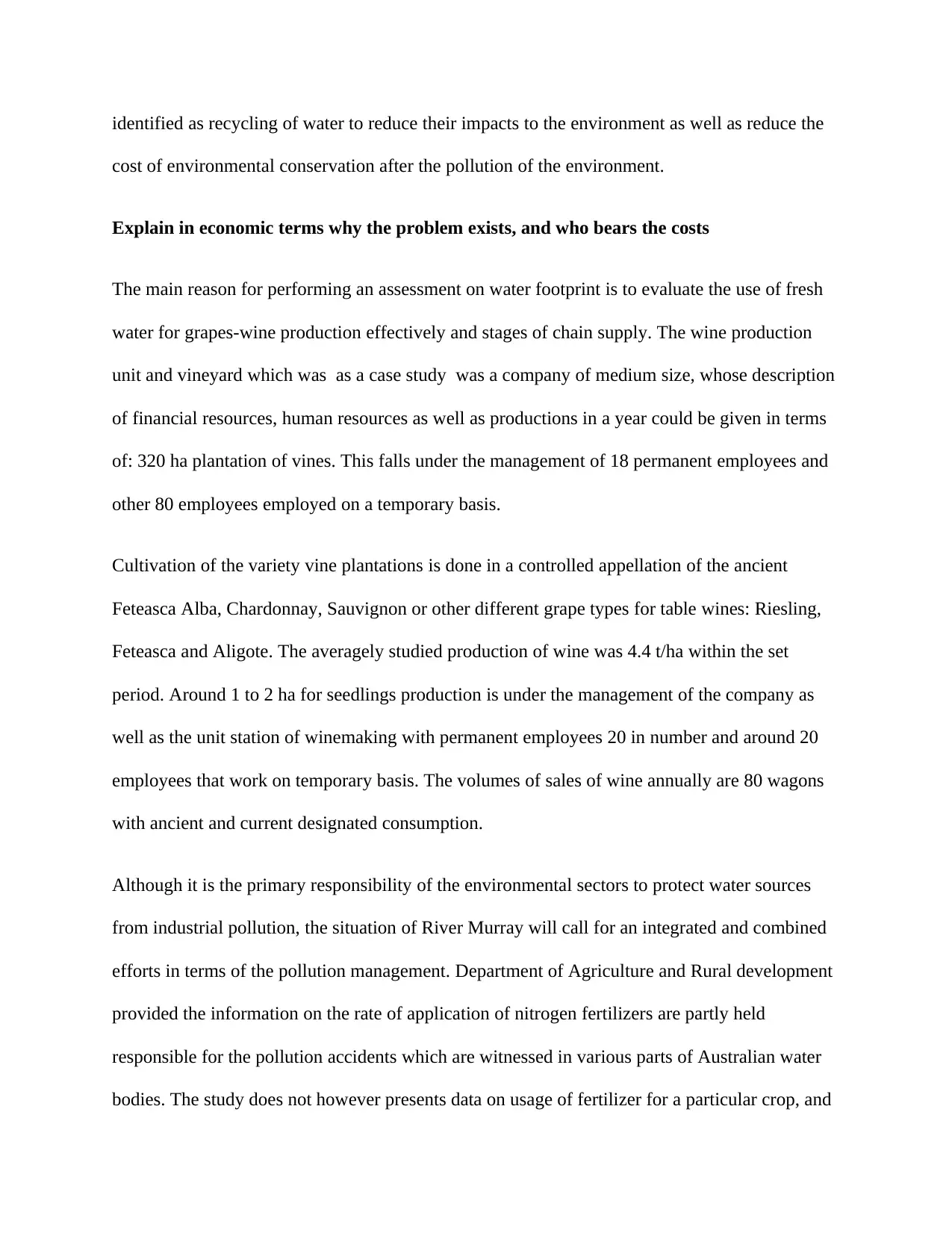
identified as recycling of water to reduce their impacts to the environment as well as reduce the
cost of environmental conservation after the pollution of the environment.
Explain in economic terms why the problem exists, and who bears the costs
The main reason for performing an assessment on water footprint is to evaluate the use of fresh
water for grapes-wine production effectively and stages of chain supply. The wine production
unit and vineyard which was as a case study was a company of medium size, whose description
of financial resources, human resources as well as productions in a year could be given in terms
of: 320 ha plantation of vines. This falls under the management of 18 permanent employees and
other 80 employees employed on a temporary basis.
Cultivation of the variety vine plantations is done in a controlled appellation of the ancient
Feteasca Alba, Chardonnay, Sauvignon or other different grape types for table wines: Riesling,
Feteasca and Aligote. The averagely studied production of wine was 4.4 t/ha within the set
period. Around 1 to 2 ha for seedlings production is under the management of the company as
well as the unit station of winemaking with permanent employees 20 in number and around 20
employees that work on temporary basis. The volumes of sales of wine annually are 80 wagons
with ancient and current designated consumption.
Although it is the primary responsibility of the environmental sectors to protect water sources
from industrial pollution, the situation of River Murray will call for an integrated and combined
efforts in terms of the pollution management. Department of Agriculture and Rural development
provided the information on the rate of application of nitrogen fertilizers are partly held
responsible for the pollution accidents which are witnessed in various parts of Australian water
bodies. The study does not however presents data on usage of fertilizer for a particular crop, and
cost of environmental conservation after the pollution of the environment.
Explain in economic terms why the problem exists, and who bears the costs
The main reason for performing an assessment on water footprint is to evaluate the use of fresh
water for grapes-wine production effectively and stages of chain supply. The wine production
unit and vineyard which was as a case study was a company of medium size, whose description
of financial resources, human resources as well as productions in a year could be given in terms
of: 320 ha plantation of vines. This falls under the management of 18 permanent employees and
other 80 employees employed on a temporary basis.
Cultivation of the variety vine plantations is done in a controlled appellation of the ancient
Feteasca Alba, Chardonnay, Sauvignon or other different grape types for table wines: Riesling,
Feteasca and Aligote. The averagely studied production of wine was 4.4 t/ha within the set
period. Around 1 to 2 ha for seedlings production is under the management of the company as
well as the unit station of winemaking with permanent employees 20 in number and around 20
employees that work on temporary basis. The volumes of sales of wine annually are 80 wagons
with ancient and current designated consumption.
Although it is the primary responsibility of the environmental sectors to protect water sources
from industrial pollution, the situation of River Murray will call for an integrated and combined
efforts in terms of the pollution management. Department of Agriculture and Rural development
provided the information on the rate of application of nitrogen fertilizers are partly held
responsible for the pollution accidents which are witnessed in various parts of Australian water
bodies. The study does not however presents data on usage of fertilizer for a particular crop, and
Paraphrase This Document
Need a fresh take? Get an instant paraphrase of this document with our AI Paraphraser
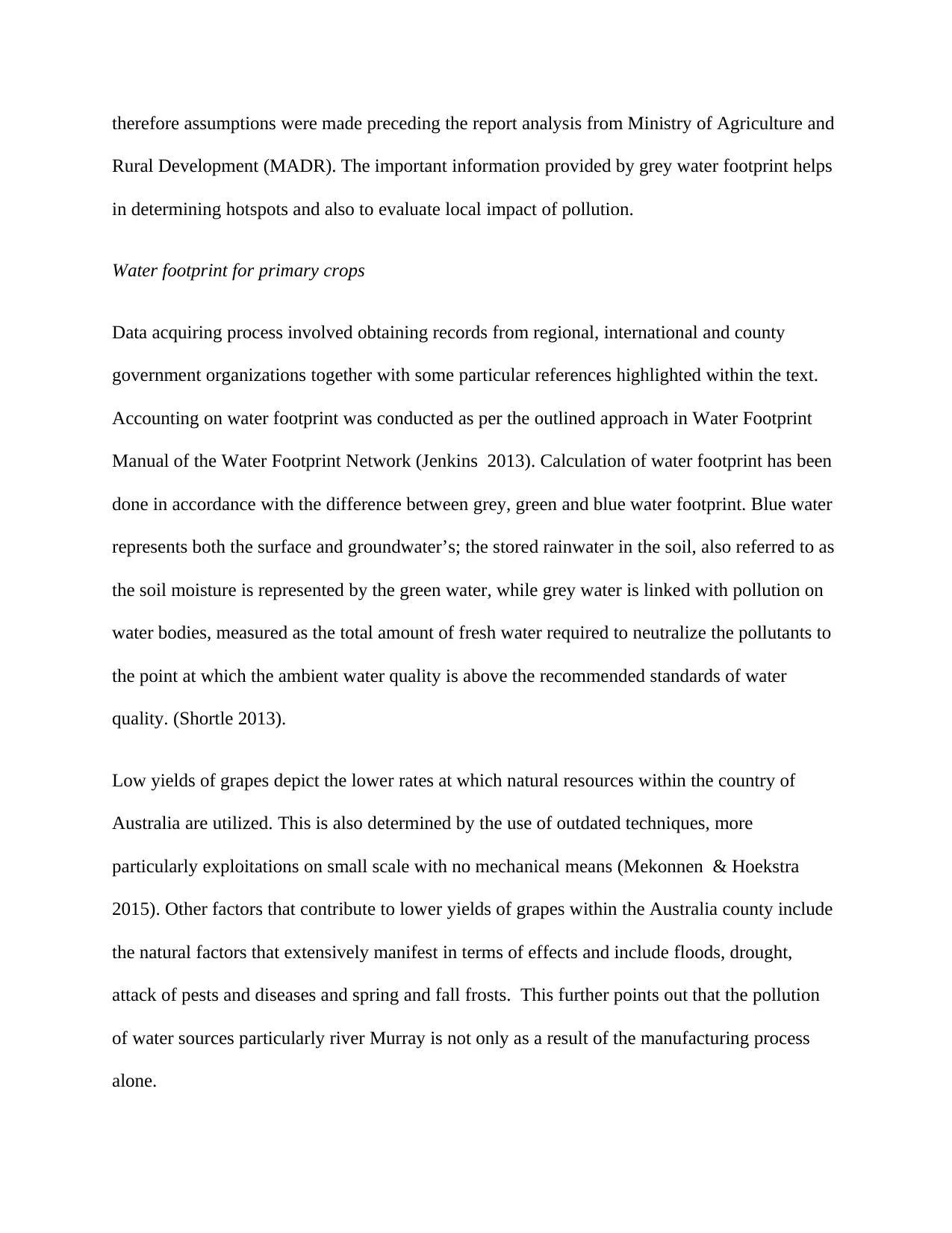
therefore assumptions were made preceding the report analysis from Ministry of Agriculture and
Rural Development (MADR). The important information provided by grey water footprint helps
in determining hotspots and also to evaluate local impact of pollution.
Water footprint for primary crops
Data acquiring process involved obtaining records from regional, international and county
government organizations together with some particular references highlighted within the text.
Accounting on water footprint was conducted as per the outlined approach in Water Footprint
Manual of the Water Footprint Network (Jenkins 2013). Calculation of water footprint has been
done in accordance with the difference between grey, green and blue water footprint. Blue water
represents both the surface and groundwater’s; the stored rainwater in the soil, also referred to as
the soil moisture is represented by the green water, while grey water is linked with pollution on
water bodies, measured as the total amount of fresh water required to neutralize the pollutants to
the point at which the ambient water quality is above the recommended standards of water
quality. (Shortle 2013).
Low yields of grapes depict the lower rates at which natural resources within the country of
Australia are utilized. This is also determined by the use of outdated techniques, more
particularly exploitations on small scale with no mechanical means (Mekonnen & Hoekstra
2015). Other factors that contribute to lower yields of grapes within the Australia county include
the natural factors that extensively manifest in terms of effects and include floods, drought,
attack of pests and diseases and spring and fall frosts. This further points out that the pollution
of water sources particularly river Murray is not only as a result of the manufacturing process
alone.
Rural Development (MADR). The important information provided by grey water footprint helps
in determining hotspots and also to evaluate local impact of pollution.
Water footprint for primary crops
Data acquiring process involved obtaining records from regional, international and county
government organizations together with some particular references highlighted within the text.
Accounting on water footprint was conducted as per the outlined approach in Water Footprint
Manual of the Water Footprint Network (Jenkins 2013). Calculation of water footprint has been
done in accordance with the difference between grey, green and blue water footprint. Blue water
represents both the surface and groundwater’s; the stored rainwater in the soil, also referred to as
the soil moisture is represented by the green water, while grey water is linked with pollution on
water bodies, measured as the total amount of fresh water required to neutralize the pollutants to
the point at which the ambient water quality is above the recommended standards of water
quality. (Shortle 2013).
Low yields of grapes depict the lower rates at which natural resources within the country of
Australia are utilized. This is also determined by the use of outdated techniques, more
particularly exploitations on small scale with no mechanical means (Mekonnen & Hoekstra
2015). Other factors that contribute to lower yields of grapes within the Australia county include
the natural factors that extensively manifest in terms of effects and include floods, drought,
attack of pests and diseases and spring and fall frosts. This further points out that the pollution
of water sources particularly river Murray is not only as a result of the manufacturing process
alone.
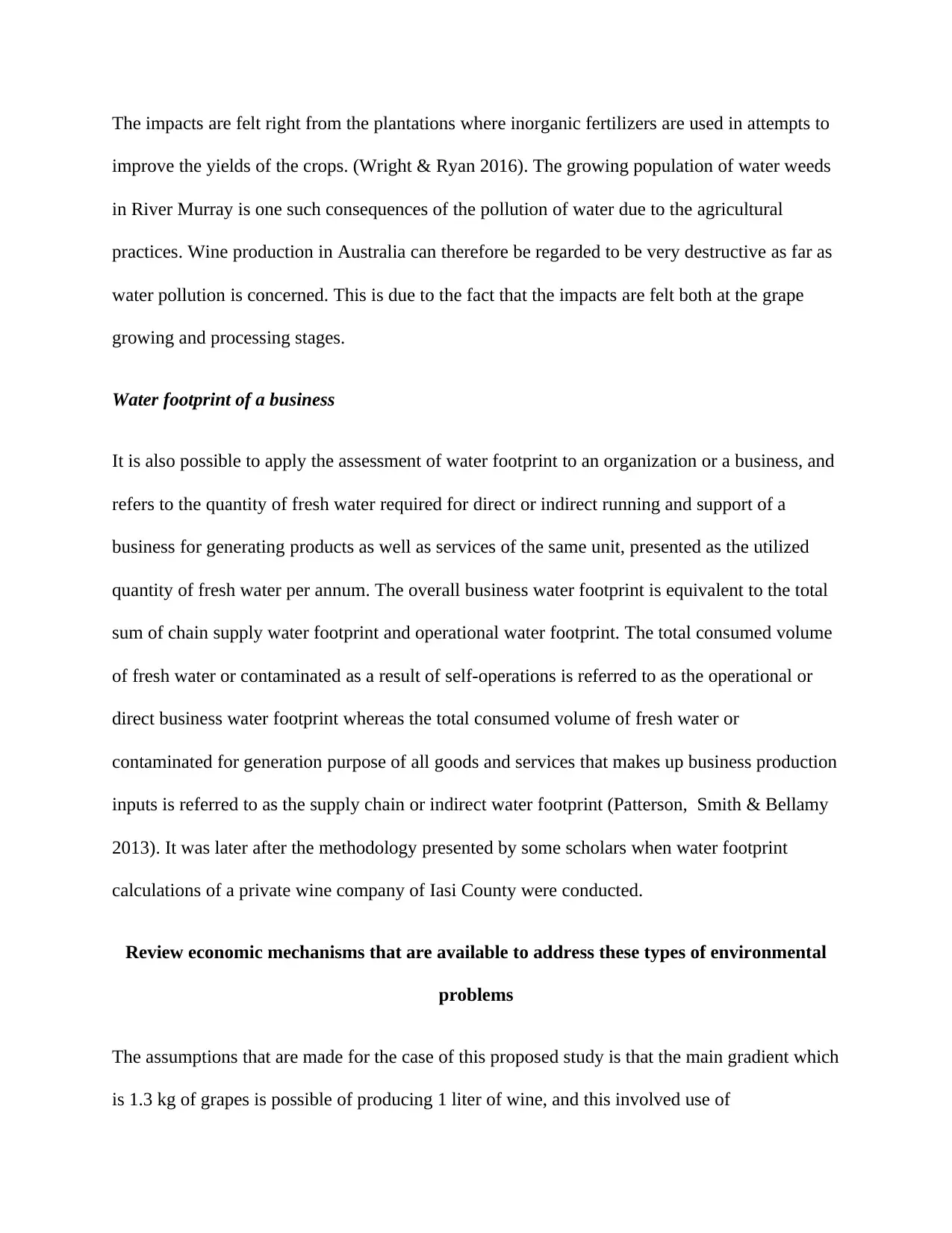
The impacts are felt right from the plantations where inorganic fertilizers are used in attempts to
improve the yields of the crops. (Wright & Ryan 2016). The growing population of water weeds
in River Murray is one such consequences of the pollution of water due to the agricultural
practices. Wine production in Australia can therefore be regarded to be very destructive as far as
water pollution is concerned. This is due to the fact that the impacts are felt both at the grape
growing and processing stages.
Water footprint of a business
It is also possible to apply the assessment of water footprint to an organization or a business, and
refers to the quantity of fresh water required for direct or indirect running and support of a
business for generating products as well as services of the same unit, presented as the utilized
quantity of fresh water per annum. The overall business water footprint is equivalent to the total
sum of chain supply water footprint and operational water footprint. The total consumed volume
of fresh water or contaminated as a result of self-operations is referred to as the operational or
direct business water footprint whereas the total consumed volume of fresh water or
contaminated for generation purpose of all goods and services that makes up business production
inputs is referred to as the supply chain or indirect water footprint (Patterson, Smith & Bellamy
2013). It was later after the methodology presented by some scholars when water footprint
calculations of a private wine company of Iasi County were conducted.
Review economic mechanisms that are available to address these types of environmental
problems
The assumptions that are made for the case of this proposed study is that the main gradient which
is 1.3 kg of grapes is possible of producing 1 liter of wine, and this involved use of
improve the yields of the crops. (Wright & Ryan 2016). The growing population of water weeds
in River Murray is one such consequences of the pollution of water due to the agricultural
practices. Wine production in Australia can therefore be regarded to be very destructive as far as
water pollution is concerned. This is due to the fact that the impacts are felt both at the grape
growing and processing stages.
Water footprint of a business
It is also possible to apply the assessment of water footprint to an organization or a business, and
refers to the quantity of fresh water required for direct or indirect running and support of a
business for generating products as well as services of the same unit, presented as the utilized
quantity of fresh water per annum. The overall business water footprint is equivalent to the total
sum of chain supply water footprint and operational water footprint. The total consumed volume
of fresh water or contaminated as a result of self-operations is referred to as the operational or
direct business water footprint whereas the total consumed volume of fresh water or
contaminated for generation purpose of all goods and services that makes up business production
inputs is referred to as the supply chain or indirect water footprint (Patterson, Smith & Bellamy
2013). It was later after the methodology presented by some scholars when water footprint
calculations of a private wine company of Iasi County were conducted.
Review economic mechanisms that are available to address these types of environmental
problems
The assumptions that are made for the case of this proposed study is that the main gradient which
is 1.3 kg of grapes is possible of producing 1 liter of wine, and this involved use of
⊘ This is a preview!⊘
Do you want full access?
Subscribe today to unlock all pages.

Trusted by 1+ million students worldwide
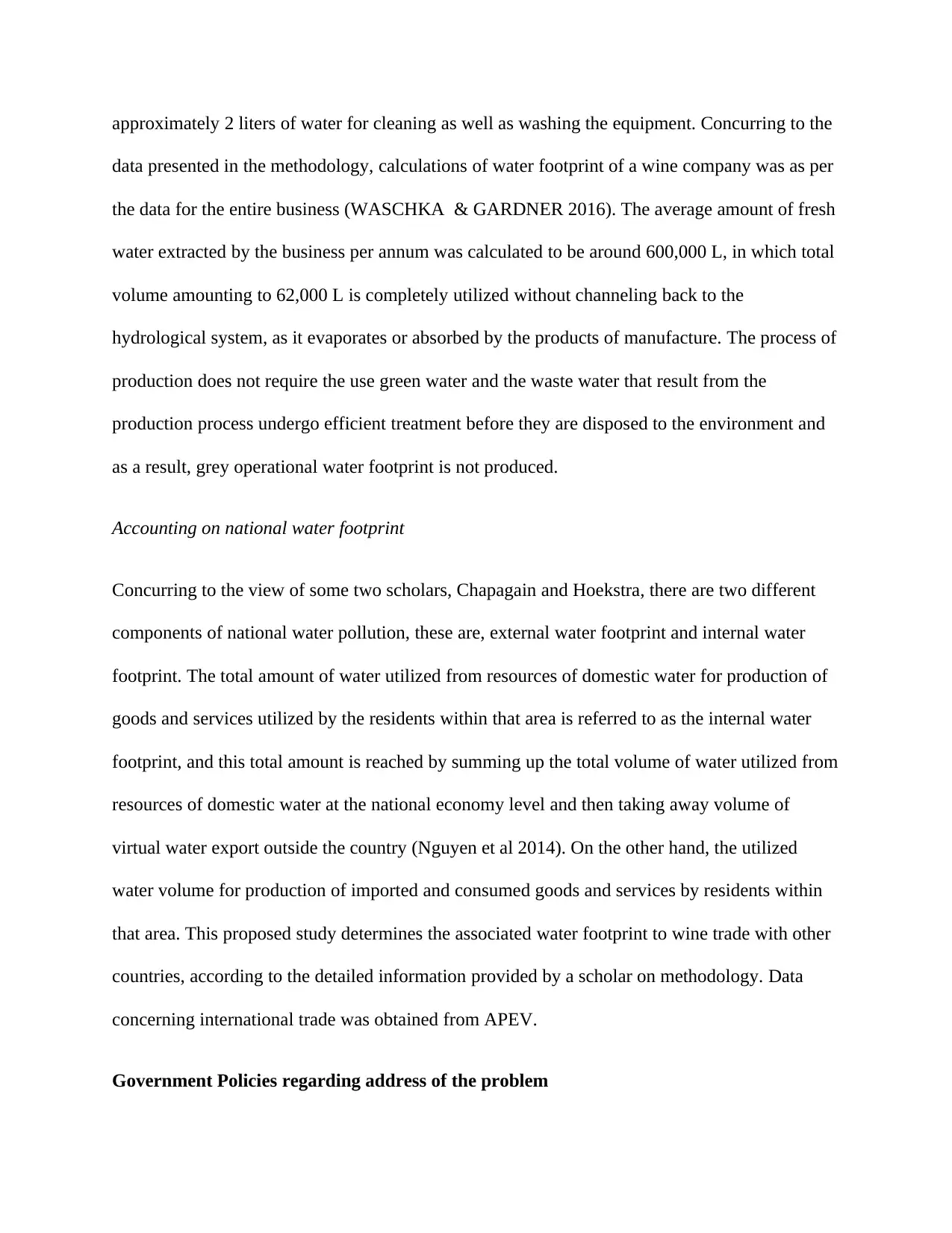
approximately 2 liters of water for cleaning as well as washing the equipment. Concurring to the
data presented in the methodology, calculations of water footprint of a wine company was as per
the data for the entire business (WASCHKA & GARDNER 2016). The average amount of fresh
water extracted by the business per annum was calculated to be around 600,000 L, in which total
volume amounting to 62,000 L is completely utilized without channeling back to the
hydrological system, as it evaporates or absorbed by the products of manufacture. The process of
production does not require the use green water and the waste water that result from the
production process undergo efficient treatment before they are disposed to the environment and
as a result, grey operational water footprint is not produced.
Accounting on national water footprint
Concurring to the view of some two scholars, Chapagain and Hoekstra, there are two different
components of national water pollution, these are, external water footprint and internal water
footprint. The total amount of water utilized from resources of domestic water for production of
goods and services utilized by the residents within that area is referred to as the internal water
footprint, and this total amount is reached by summing up the total volume of water utilized from
resources of domestic water at the national economy level and then taking away volume of
virtual water export outside the country (Nguyen et al 2014). On the other hand, the utilized
water volume for production of imported and consumed goods and services by residents within
that area. This proposed study determines the associated water footprint to wine trade with other
countries, according to the detailed information provided by a scholar on methodology. Data
concerning international trade was obtained from APEV.
Government Policies regarding address of the problem
data presented in the methodology, calculations of water footprint of a wine company was as per
the data for the entire business (WASCHKA & GARDNER 2016). The average amount of fresh
water extracted by the business per annum was calculated to be around 600,000 L, in which total
volume amounting to 62,000 L is completely utilized without channeling back to the
hydrological system, as it evaporates or absorbed by the products of manufacture. The process of
production does not require the use green water and the waste water that result from the
production process undergo efficient treatment before they are disposed to the environment and
as a result, grey operational water footprint is not produced.
Accounting on national water footprint
Concurring to the view of some two scholars, Chapagain and Hoekstra, there are two different
components of national water pollution, these are, external water footprint and internal water
footprint. The total amount of water utilized from resources of domestic water for production of
goods and services utilized by the residents within that area is referred to as the internal water
footprint, and this total amount is reached by summing up the total volume of water utilized from
resources of domestic water at the national economy level and then taking away volume of
virtual water export outside the country (Nguyen et al 2014). On the other hand, the utilized
water volume for production of imported and consumed goods and services by residents within
that area. This proposed study determines the associated water footprint to wine trade with other
countries, according to the detailed information provided by a scholar on methodology. Data
concerning international trade was obtained from APEV.
Government Policies regarding address of the problem
Paraphrase This Document
Need a fresh take? Get an instant paraphrase of this document with our AI Paraphraser
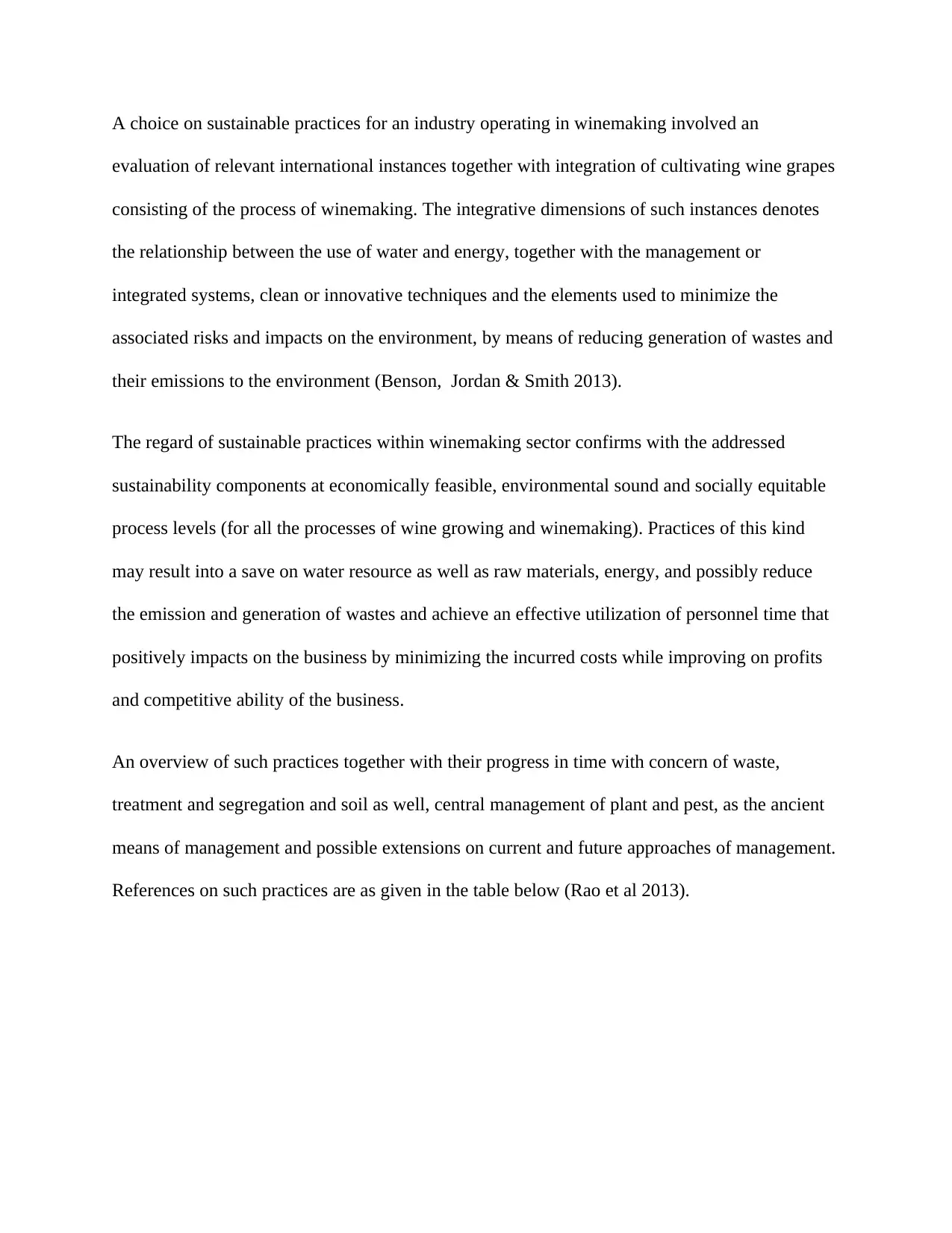
A choice on sustainable practices for an industry operating in winemaking involved an
evaluation of relevant international instances together with integration of cultivating wine grapes
consisting of the process of winemaking. The integrative dimensions of such instances denotes
the relationship between the use of water and energy, together with the management or
integrated systems, clean or innovative techniques and the elements used to minimize the
associated risks and impacts on the environment, by means of reducing generation of wastes and
their emissions to the environment (Benson, Jordan & Smith 2013).
The regard of sustainable practices within winemaking sector confirms with the addressed
sustainability components at economically feasible, environmental sound and socially equitable
process levels (for all the processes of wine growing and winemaking). Practices of this kind
may result into a save on water resource as well as raw materials, energy, and possibly reduce
the emission and generation of wastes and achieve an effective utilization of personnel time that
positively impacts on the business by minimizing the incurred costs while improving on profits
and competitive ability of the business.
An overview of such practices together with their progress in time with concern of waste,
treatment and segregation and soil as well, central management of plant and pest, as the ancient
means of management and possible extensions on current and future approaches of management.
References on such practices are as given in the table below (Rao et al 2013).
evaluation of relevant international instances together with integration of cultivating wine grapes
consisting of the process of winemaking. The integrative dimensions of such instances denotes
the relationship between the use of water and energy, together with the management or
integrated systems, clean or innovative techniques and the elements used to minimize the
associated risks and impacts on the environment, by means of reducing generation of wastes and
their emissions to the environment (Benson, Jordan & Smith 2013).
The regard of sustainable practices within winemaking sector confirms with the addressed
sustainability components at economically feasible, environmental sound and socially equitable
process levels (for all the processes of wine growing and winemaking). Practices of this kind
may result into a save on water resource as well as raw materials, energy, and possibly reduce
the emission and generation of wastes and achieve an effective utilization of personnel time that
positively impacts on the business by minimizing the incurred costs while improving on profits
and competitive ability of the business.
An overview of such practices together with their progress in time with concern of waste,
treatment and segregation and soil as well, central management of plant and pest, as the ancient
means of management and possible extensions on current and future approaches of management.
References on such practices are as given in the table below (Rao et al 2013).
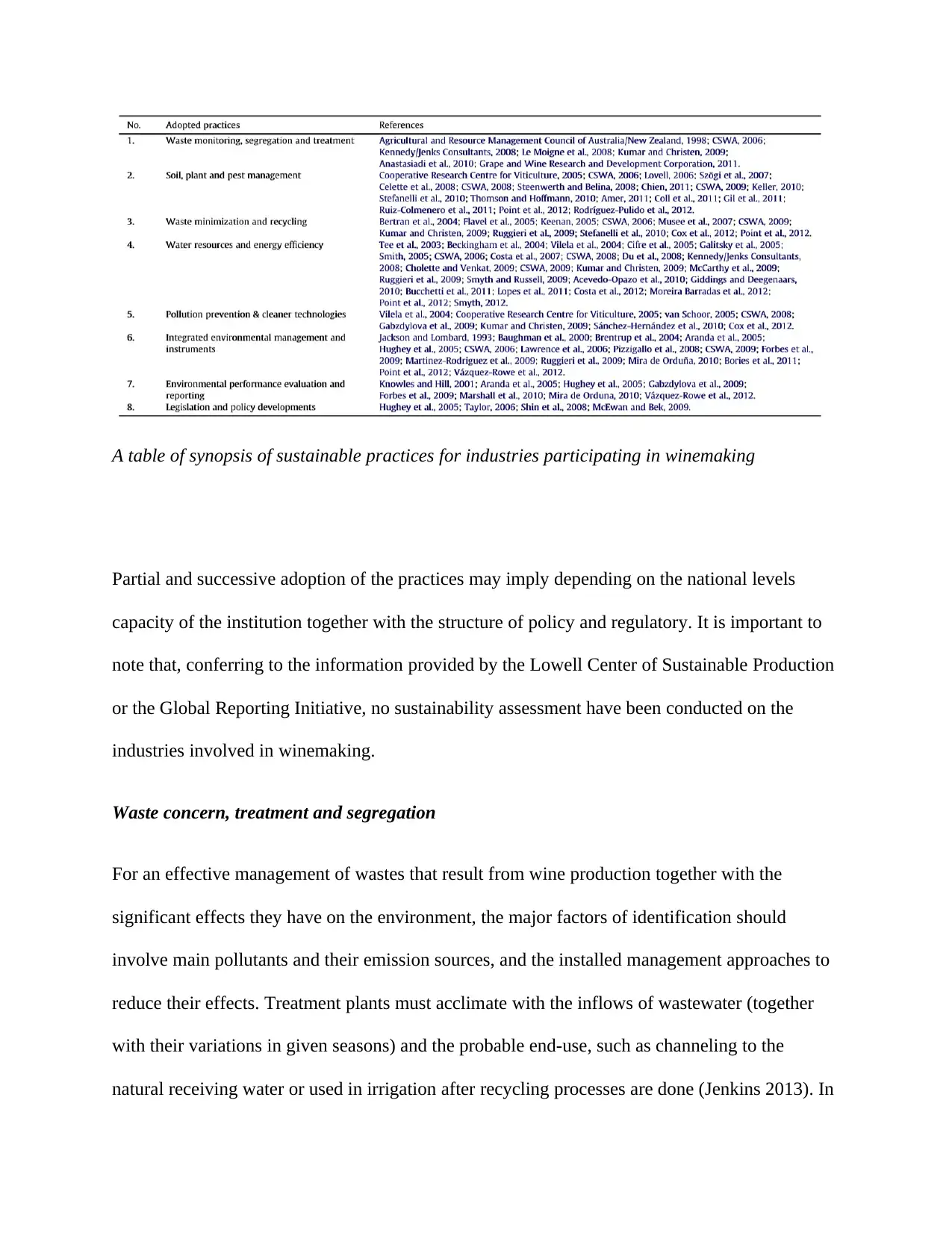
A table of synopsis of sustainable practices for industries participating in winemaking
Partial and successive adoption of the practices may imply depending on the national levels
capacity of the institution together with the structure of policy and regulatory. It is important to
note that, conferring to the information provided by the Lowell Center of Sustainable Production
or the Global Reporting Initiative, no sustainability assessment have been conducted on the
industries involved in winemaking.
Waste concern, treatment and segregation
For an effective management of wastes that result from wine production together with the
significant effects they have on the environment, the major factors of identification should
involve main pollutants and their emission sources, and the installed management approaches to
reduce their effects. Treatment plants must acclimate with the inflows of wastewater (together
with their variations in given seasons) and the probable end-use, such as channeling to the
natural receiving water or used in irrigation after recycling processes are done (Jenkins 2013). In
Partial and successive adoption of the practices may imply depending on the national levels
capacity of the institution together with the structure of policy and regulatory. It is important to
note that, conferring to the information provided by the Lowell Center of Sustainable Production
or the Global Reporting Initiative, no sustainability assessment have been conducted on the
industries involved in winemaking.
Waste concern, treatment and segregation
For an effective management of wastes that result from wine production together with the
significant effects they have on the environment, the major factors of identification should
involve main pollutants and their emission sources, and the installed management approaches to
reduce their effects. Treatment plants must acclimate with the inflows of wastewater (together
with their variations in given seasons) and the probable end-use, such as channeling to the
natural receiving water or used in irrigation after recycling processes are done (Jenkins 2013). In
⊘ This is a preview!⊘
Do you want full access?
Subscribe today to unlock all pages.

Trusted by 1+ million students worldwide
1 out of 17
Related Documents
Your All-in-One AI-Powered Toolkit for Academic Success.
+13062052269
info@desklib.com
Available 24*7 on WhatsApp / Email
![[object Object]](/_next/static/media/star-bottom.7253800d.svg)
Unlock your academic potential
Copyright © 2020–2025 A2Z Services. All Rights Reserved. Developed and managed by ZUCOL.




